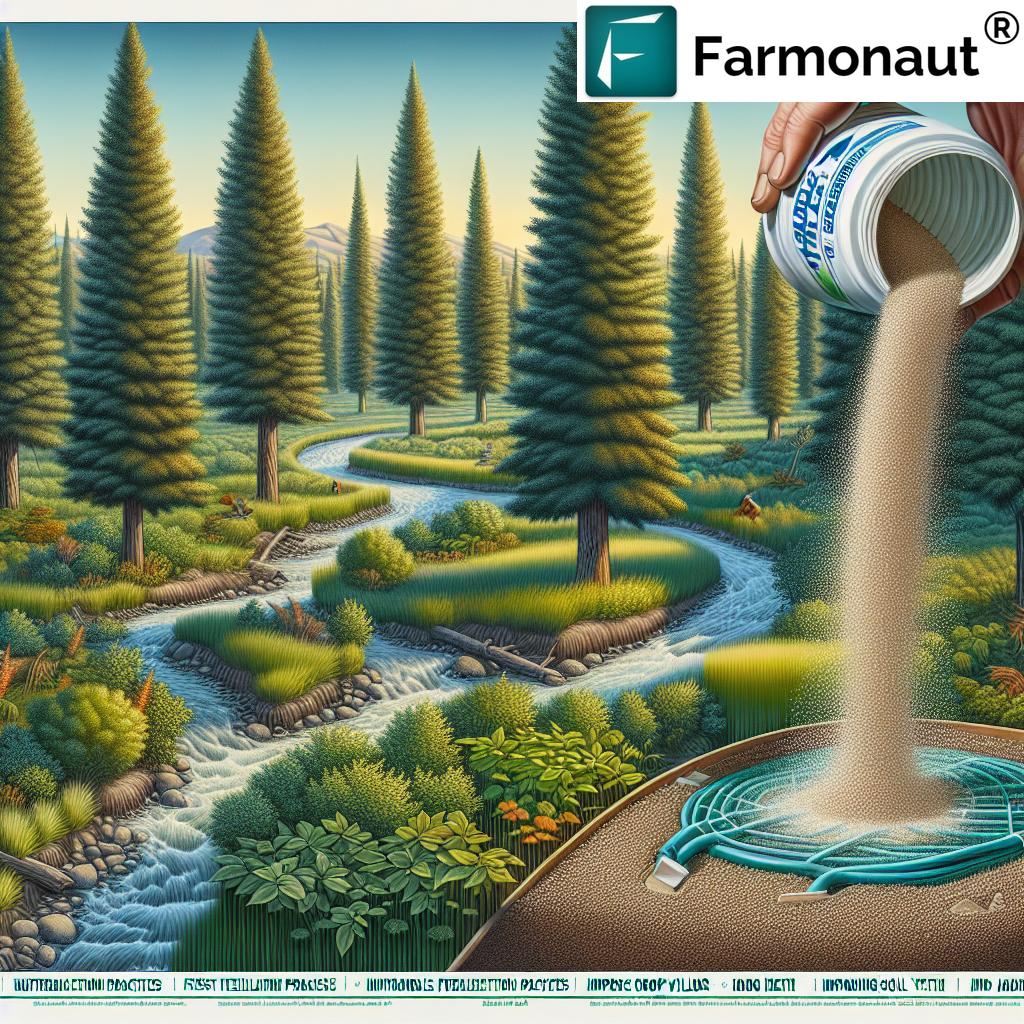Table of Contents
- Introduction: Idaho Fertilization & Its Crucial Role in Yields
- Trivia: Idaho Fertilization Fun Fact
- Why Fertilization Matters for Idaho Agriculture & Forestry
- Idaho Fertilization: The 7 Secrets to Boosting Yields
- Secret 1: Soil Testing in Idaho – The Foundation for Nutrient Success
- Secret 2: Advanced Nutrient Management Practices in Idaho
- Secret 3: Fertilization Guidelines & Variable Rate Application
- Secret 4: Forest Fertilization Practices for Idaho Timberlands
- Secret 5: Best Management Practices for Sustainable Fertilization
- Secret 6: Enhancing Idaho Soil Health & Sustainable Agriculture
- Secret 7: Navigating Idaho Agricultural Regulations & Resources
- Comparison Table: Sustainable Fertilization Practices & Impacts
- Farmonaut: Precision Agriculture for Idaho’s Sustainable Future
- Trivia: Environmental Impact of Sustainable Fertilization
- FAQ: Idaho Fertilization and Soil Management
- Farmonaut Subscription Plans
- Conclusion: Growing Idaho’s Future Sustainably
Idaho Fertilization: Boost Yields With These 7 Secrets!

Why Fertilization Matters for Idaho Agriculture & Forestry
As farmers and land stewards in Idaho, we understand that fertilization plays a pivotal role in the state’s agricultural and forestry productivity. Whether we’re cultivating potatoes on the Snake River Plain or managing Douglas-fir in northern Idaho’s forests, supplying essential nutrients is crucial for optimal plant growth, improving crop yields, and maintaining soil health.
However, effective fertilization isn’t just about applying fertilizer. To truly support sustainability and protect Idaho’s natural resources, we must understand our soil characteristics, crop requirements, and environmental considerations. This approach ensures that every field, grove, or forest is managed to its unique needs—achieving the perfect balance for both productivity and sustainability.
In this in-depth guide, we’ll uncover the 7 secrets every Idaho grower should know about sustainable fertilization—with actionable steps, local resources, and cutting-edge technologies to improve yields and protect our state’s environment.
Idaho Fertilization: The 7 Secrets to Boosting Yields
- Soil Testing in Idaho: Building a Fertility Baseline
- Nutrient Management Practices: Matching Needs With Supply
- Precision Fertilization & Variable Rate Application
- Forest Fertilization Practices for Idaho Timberlands
- Best Management Practices to Protect Water & Wildlife
- Enhancing Idaho Soil Health for Sustainable Agriculture
- Compliance with Idaho Agricultural Regulations & Using Local Resources
Secret 1: Soil Testing in Idaho – The Foundation for Nutrient Success
Soil testing in Idaho is the cornerstone of any effective fertilization plan. Before we even think about applying fertilizer, it’s crucial to assess current nutrient levels in our soil. This practice enables us to determine the nutrient needs of our crops, preventing over-fertilization and costly input waste.
In Idaho, best practice recommends:
- Timing: Conduct soil testing 2–4 weeks before planting.
- Sampling Depth: Collect samples to a depth of 2 feet to cover the rooting zone.
- Sampling Rate: Take at least one soil sample per acre for accuracy.
We can access detailed soil sampling and testing guidelines from the University of Idaho Extension. Accurately interpreting these results allows us to tailor nutrient strategies for specific soil characteristics. This is particularly important for Idaho’s diverse landscape, from irrigated croplands to volcanic soils and semi-arid rangelands.
-
Benefits:
- Improves fertilizer efficiency
- Reduces risk of water contamination
- Guides optimal application rates
Step-by-Step: How We Perform Soil Testing in Idaho
- Plan your sampling before spring field operations.
- Divide larger fields into management zones based on cropping history and visible differences.
- Clear surface debris and collect soil using a probe or auger.
- Sample to a uniform depth (24 inches, or 2 feet).
- Combine multiple cores from each zone into one composite sample per acre.
- Label and send samples promptly to a qualified Idaho lab.
The test results will help us select the right fertilizer sources, application methods, and schedules—all tailored to our specific zone and crop, such as dry beans, potatoes, wheat, or forage grasses.
For remote monitoring of changes in soil moisture and crop vigor, platforms like Farmonaut offer satellite-based soil health diagnostics and real-time crop health reports, providing Idaho producers with affordable insights season-long.
Secret 2: Advanced Nutrient Management Practices in Idaho
Once we have reliable soil test data, we can move forward with nutrient management practices that match the supply of nutrients precisely to our crop needs. Good nutrient management not only boosts yields but also protects our water resources and the environment by minimizing nutrient losses.
- Right Source: Select the most suitable type of fertilizer—for example, ammonium nitrate, urea, or organic manure—depending on soil test results and upcoming crop requirements.
- Right Rate: Use University of Idaho recommendations to adjust application rates for each acre and crop based on yield targets.
- Right Time: Align applications with crop growth stages (emergence, tillering, flowering) to match key nutrient demand periods.
- Right Place: Incorporate or band application to reduce runoff and improve root uptake, rather than simple broadcasting.
Dry beans—commonly cultivated in Idaho—have lower fertilizer needs due to their unique ability to fix atmospheric nitrogen. However, we must still test for phosphorus, potassium, and micronutrients to avoid deficiencies.
According to the University of Idaho Extension, rotating legumes with cereals, incorporating crop residues, and adjusting applications post-harvest are key strategies for sustainable nutrient management.
Innovative Nutrient Management to Improve Efficiency & Sustainability
Organizations like the Innovative Agriculture and Marketing Partnership (IAMP) in Idaho are leading the way in advanced, high-efficiency practices:
- Reducing synthetic nitrogen fertilizer use in Idaho by 15% through variable rate application, inhibitors, and field mapping
- Increasing nitrogen use efficiency—so more applied nitrogen gets into the plant, not lost to the environment
- Economic benefits by cutting unnecessary fertilizer costs
Secret 3: Fertilization Guidelines & Variable Rate Application
The ability to apply the right amount of fertilizer in the right place—known as precision fertilization or variable rate application—transforms sustainable nutrient management.
- Boosting Crop Yields in Idaho: By using site-specific soil and crop data, we can adjust fertilizer rates across a field—supplying less where residual fertility is high and more where deficiencies exist. This reduces resource waste and improves yields Idaho growers rely on.
- Utilizing Innovative Technologies: Satellite monitoring, like that offered by Farmonaut’s large-scale farm management platform, enables real-time detection of underperforming areas and supports individualized fertilization strategies that directly enhance both yields and ROI.
- Precision fertilization has been shown to increase nitrogen use efficiency and improve soil health by minimizing hotspots of excess nutrient application.
- Incorporating modern Farmonaut’s API solutions into machinery can automate data-driven fertilization for maximum efficiency in Idaho’s large and small operations.
- For developers, Farmonaut’s weather & satellite data developer docs offer deep insights to further refine farm-level management platforms.
Secret 4: Forest Fertilization Practices for Idaho Timberlands
Forestry in Idaho also benefits from fertilization to support tree growth and forest regeneration, especially after harvest. The right fertilization practices can enhance volume growth, strengthen ecosystem health, and even promote carbon capture.
According to research from the University of Idaho, applying 200 pounds of nitrogen per acre has resulted in up to a 14% increase in cubic volume for unthinned stands and a 23% increase for thinned stands over a 14-year period for species like grand fir and Douglas-fir.
- Application Timing: Fertilize forests during spring or early fall for maximum uptake.
- Monitoring: Satellite-based platforms, similar to Farmonaut’s forest advisory service, help in tracking forest stand health and determining the best times for application.
- Avoiding Over-Fertilization: Research warns that over-applying nitrogen may increase trees’ susceptibility to certain pests and diseases.
- Balanced Application: Along with nitrogen, consider incorporating potassium and micronutrients, especially when managing ponderosa pine, to enhance resistance and growth.
Effective forest fertilization helps with carbon sequestration, improves biodiversity, and supports the long-term sustainability of Idaho’s timber industry.
Secret 5: Best Management Practices for Sustainable Fertilization
Responsible fertilization means safeguarding our water quality, wildlife habitat, and Idaho’s natural beauty. We must minimize nutrient runoff, prevent groundwater contamination, and manage inputs wisely. Here’s how:
Key Idaho Fertilization Best Management Practices
- Buffer Strips: Plant vegetative buffers along streams, rivers, and irrigation ditches to filter out excess nitrogen and phosphates.
- Conservative Application: Follow recommended rates and educate all users to prevent contamination.
- Cover Crops: Use winter cover crops to capture residual nutrients, enhance organic matter, and reduce erosion.
- Incorporate Fertilizer: Mix fertilizers into the soil instead of leaving them on the surface to reduce runoff during rain or irrigation.
- Monitor Water Quality: Test water inflow and outflow points for nitrate levels—especially if fields drain into public waterways.
The practice of adopting best management practices for fertilization is strongly supported by entities like the Idaho Rural Water Association and is in accordance with the Idaho Forest Practices Act.
Secret 6: Enhancing Idaho Soil Health & Sustainable Agriculture
Healthy soil is the engine of sustainable agriculture in Idaho. A thriving soil ecosystem boosts fertility, crop resilience, and water-holding capacity—while also storing carbon and reducing greenhouse gas emissions.
Practices promoted by the USDA Natural Resources Conservation Service (NRCS) and local extension offices include:
- No-till or reduced-till farming: Protect soil structure and organic matter, reducing erosion.
- Cover Cropping: Rye, vetch, or clover can fix atmospheric nitrogen naturally and provide root structure for soil microbes.
- Rotating Crops: Rotate dry beans, cereals, and oilseeds to disrupt disease cycles and improve soil health.
- Organic Matter Addition: Incorporate compost or green manure after harvest to increase nutrient supply and soil aggregation.
- Smart Water Management: Schedule irrigation to avoid waterlogging and leaching of valuable nutrients.
Idaho soil health is best monitored with a mix of field data and remote-sensing analytics. Farmonaut’s satellite imagery and AI-powered soil reports allow us to see soil moisture trends, crop stress, and early warnings for nutrient imbalances, directly from our mobile or desktop device.
Not only do these sustainable agriculture practices increase yields over time, but they also position Idaho growers to meet the evolving expectations of consumers, buyers, and regulatory agencies.
Secret 7: Navigating Idaho Agricultural Regulations & Using Local Resources
For long-term success, Idaho growers must ensure their fertilization, soil management, and harvest practices are in full compliance with state agricultural regulations and supported by reliable, science-based resources.
- Idaho State Department of Agriculture (ISDA): Oversees all fertilizer and soil amendment regulations in the state, ensuring quality, safety, and labeling accuracy. Check their fertilizer lab for quality standards
- Forest Practices Act: Mandates reforestation within five years of harvest, protection of stream beds, and maintenance of buffer strips when applying fertilizer near watercourses.
- University Extension Resources: The University of Idaho Extension provides comprehensive fertilization guidelines for Idaho farmers, covering everything from soil sampling protocols to specific crop recommendations.
- Continual Education: Access state-supported education, field days, and workshops to stay updated on the latest nutrient management trends and compliance requirements.
By weaving these regulations and resources into our farm plans, we protect Idaho’s iconic landscapes while maximizing productivity.
Comparison Table: Sustainable Fertilization Practices and Their Estimated Impact in Idaho
To help us visualize the impact of various Idaho fertilization practices, here’s a detailed comparison table. This tool aids growers and land managers in selecting eco-friendly, productive, and sustainable solutions for their operations.
| Fertilization Practice | Description | Estimated Yield Increase (%) | Soil Health Impact | Environmental Benefit | Suitability for Idaho (1-5) |
|---|---|---|---|---|---|
| Soil Testing | Routine assessment of nutrient levels, pH, and organic matter before fertilization. | 8–15% | Significantly improves soil health by preventing imbalances and salt accumulation. | Reduces risk of water contamination from over-application. | 5 |
| Precision Nutrient Application | Variable rate equipment & satellite-guided fertilization tailored to field zones. | 12–20% | Maintains balanced fertility, avoids hotspots of excess nutrients. | Minimizes input waste and off-field runoff. | 5 |
| Use of Organic Fertilizers | Applying manure, compost, or green manures to boost soil organic matter. | 7–12% | Increases microbial activity and soil aggregation. | Improves carbon storage and soil biodiversity. | 4 |
| Cover Cropping | Sowing legumes or grasses off-season to capture nutrients and protect soil. | 5–10% | Boosts soil structure, organic matter, and nitrogen fixation. | Reduces erosion, nutrient leaching. | 5 |
| Nitrogen Inhibitors | Chemical inhibitors slow the conversion and loss of applied nitrogen. | 4–8% | Stabilizes N supply in soil, minimizes volatilization. | Less nitrous oxide emissions and groundwater nitrate. | 4 |
| Buffer Strips & Riparian Zones | Planting OF vegetated buffers along streams and ditches. | 3–7% | Protects soil at field edges, improves overall health. | Traps runoff, protects aquatic ecosystems. | 5 |
| Balanced N-P-K & Micronutrient Programs | Applying fertilizer based on precise crop needs throughout the season. | 10–16% | Prevents nutrient deficiencies, preserves root zone health. | Less overall fertilizer used, lower risk of excess buildup. | 5 |
Farmonaut: Precision Agriculture for Idaho’s Sustainable Future
Now that we’ve covered the secrets to successful fertilization in Idaho, let’s explore how technology and innovation can supercharge our stewardship—balancing productivity, environmental health, and regulatory compliance.
Farmonaut’s Satellite & AI-Driven Tools for Idaho Growers
Farmonaut is an agricultural technology leader offering satellite-based farm management, real-time crop health monitoring, AI-powered advisory, and blockchain-based traceability via web, Android, iOS apps, and robust APIs. The mission? To make affordable, data-driven precision agriculture accessible across Idaho and worldwide.
- Real-time Crop Health Monitoring: Multispectral satellite images reveal NDVI (vegetative vigor), soil moisture, and early crop stress—enabling timely fertilizer, irrigation, and pest management decisions.
- AI-based Advisories: Farmonaut’s Jeevn AI system analyzes weather, satellite, and field data to deliver tailored, actionable crop management insights for Idaho’s diverse ag systems.
- Carbon Footprint Tracking: Farmonaut’s carbon footprint tool helps Idaho growers understand and lower environmental impact, crucial for stewardship and compliance.
- Traceability for Supply Chain Transparency: Farmonaut’s blockchain-enabled product traceability solution ensures that every stage of the Idaho ag supply chain—from field to consumer—is transparent and secure, building consumer trust and reducing fraud.
- Resource & Fleet Management: Fleet management tools optimize agri-business budgets, vehicle safety, and timely logistics on large Idaho farms and forestry operations.
- Financial Access: Crop loan and insurance tools provide satellite-based field verification, streamlining the process for Idaho farmers and reducing fraud for financial institutions.
Farmonaut’s flexible subscription model enables individual farmers, agribusinesses, and policy makers to precisely choose and scale the digital tools that best fit their operations:
FAQ: Idaho Fertilization and Soil Management
What are the best fertilization practices for Idaho soils?
Start with soil testing to assess nutrient levels and pH. Use precision fertilization and variable rate application to match nutrient supply with crop demand. Integrate cover crops, managed rotations, and buffer strips for best environmental outcomes.
How often should soil testing be performed in Idaho?
At least once per season, ideally 2–4 weeks before planting. Sample each acre or management zone to a 2-foot depth for the most accurate nutrient assessment.
Which Idaho crops require the most fertilizer input?
Potatoes, wheat, and specialty crops generally have higher nutrient requirements. Dry beans fix atmospheric nitrogen but still require phosphorus, potassium, and micronutrient supplementation based on soil tests.
How do Idaho agricultural regulations impact fertilization?
ISDA oversees fertilizer quality and safety. Compliance with reforestation, water protections, and buffer strip standards is mandatory—these protect Idaho’s soils, forests, and waterways.
What tools are available for monitoring crop health and scheduling fertilizer application?
Satellite and AI-driven tools such as Farmonaut’s crop health monitoring platform provide real-time NDVI, soil moisture, and weather data for smarter input scheduling and sustainable farm management.
Conclusion: Growing Idaho’s Future Sustainably
Fertilization is the linchpin of Idaho’s agricultural and forestry productivity, but responsible management is key to lasting prosperity. By adopting cutting-edge soil testing in Idaho, refining nutrient management practices, following science-based fertilization guidelines for Idaho farmers, and incorporating advanced digital tools from Farmonaut, we can boost yields, maintain soil health, and protect the state’s water and ecosystem resources.
As we move forward into a future of sustainable agriculture Idaho is proud to champion, remember that optimal plant, crop, and forest growth begins with understanding, stewardship, and the willingness to innovate. Idaho’s soils are our legacy—let’s support, enhance, and protect them for generations to come.
Learn more about precision soil and crop monitoring, AI-based advisory, and farm traceability solutions by visiting Farmonaut’s platform today.














